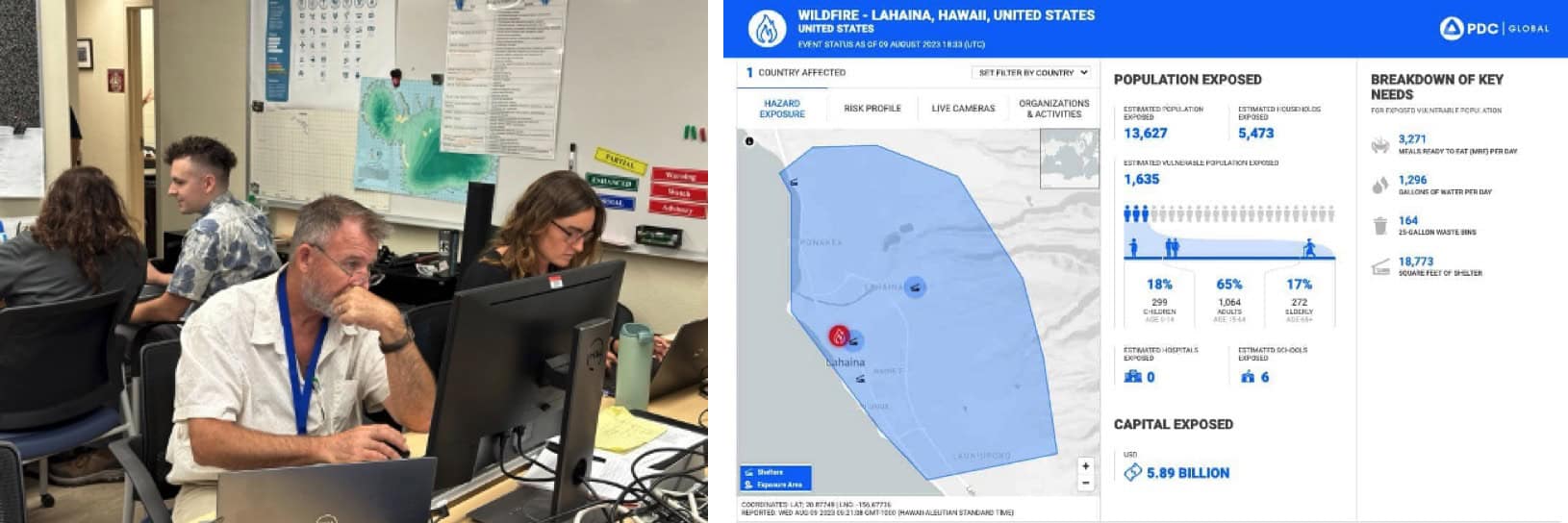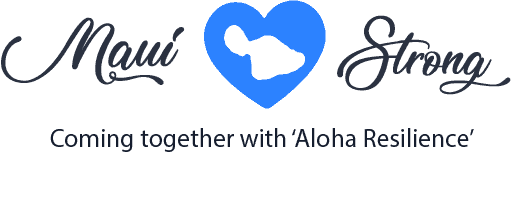
PDC’s message of hope and commitment to Maui’s resilience and recovery
Maui Island, HI—August 8, 2024, marks a somber anniversary for the Maui community and the Pacific Disaster Center (PDC), forever etched memory as we faced the most devastating U.S. wildfire in over a century. We take a moment to thank the many organizations, agencies, and individuals who have exhibited unwavering heroism and commitment to the ongoing recovery process.
Recounting the events of that fateful day as fires swept across Maui, the historic town of Lahaina—once the Hawaiian Kingdom’s capital and a beloved tourist destination—was reduced to rubble within just a few hours. Fueled by 80 mph winds from Hurricane Dora, the fire demolished nearly every structure, melted vehicles gridlocked in traffic, and engulfed Lahaina’s iconic boat harbor.
The fire displaced over 9,000 residents, destroyed hundreds of businesses, and claimed more than 100 lives. As Lahaina burned, the island’s first responders were pulled in numerous directions to fight fires happening across the island, five in total, including a sizable blaze in the upcountry town of Kula.
“PDC was born out of the devastation on the island of Kauai…but on August 8th 2023, it was our community, our family, and our neighbors who needed us the most.”
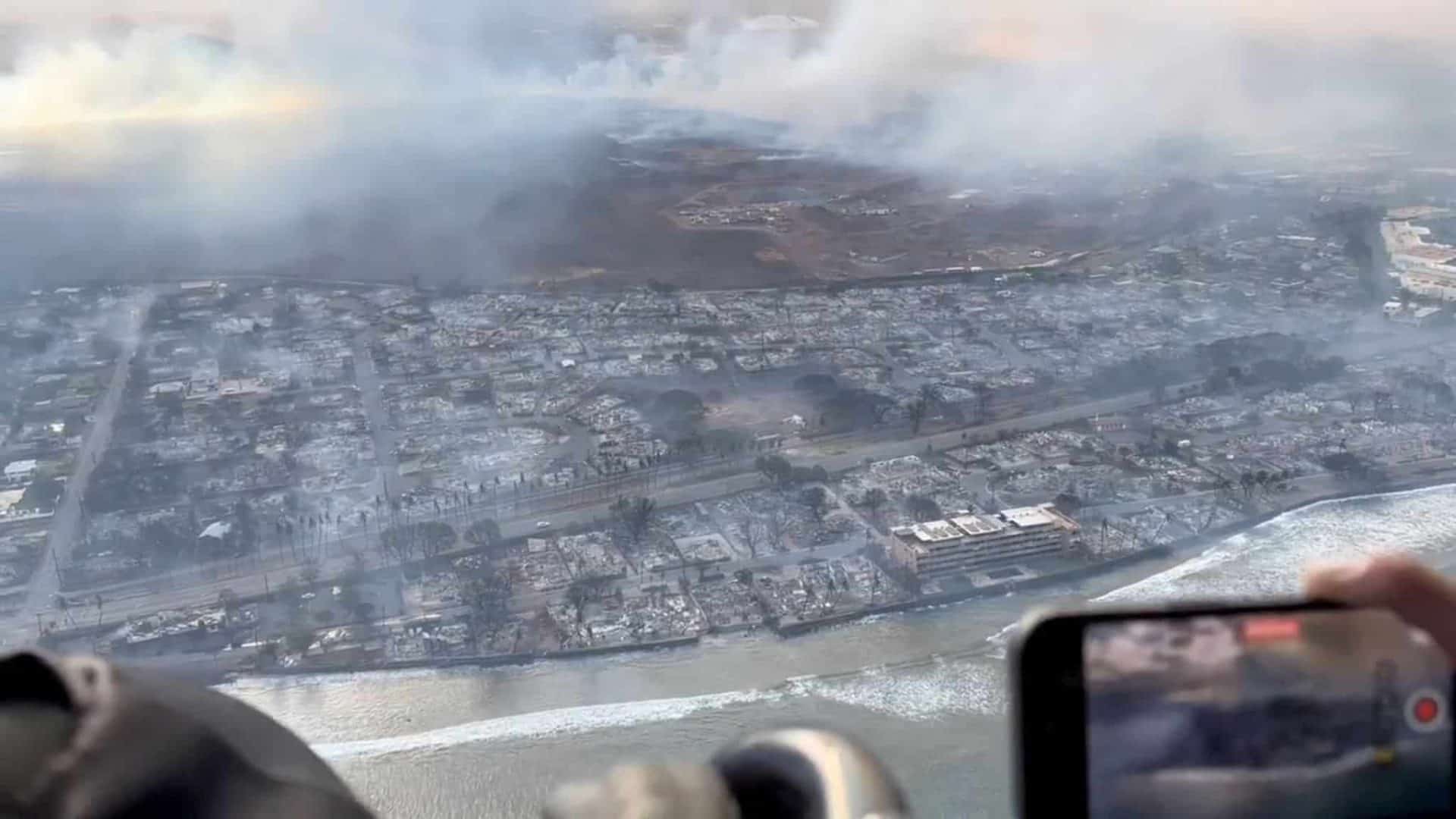
“PDC was born out of the devastation on the island of Kauai, following Hurricane Iniki 1992. Since then, PDC has focused on applying the best science and technology to strengthen early warning and advanced analytics. Our commitment is global but on August 8th, 2023, it was our community, our family, and our neighbors who needed us the most,” said PDC’s Executive Director Ray Shirkhodai.
The extent of the fires that devastated Maui didn’t become clear until the early morning of August 9, 2023. As dawn broke, flyover footage of Lahaina’s destruction shocked the world, with the first images emerging on social media from news reports.
Immediate Response and Support
In the immediate aftermath, PDC quickly mobilized, utilizing its advanced All-Hazards Impact Model (AIM), DisasterAWARE platform, and sophisticated data science capabilities and technologies. The Center’s initial focus was on assessing the impacts on population and infrastructure. By the morning of August 9, PDC released preliminary estimates, aiding decision-makers in understanding the scale of humanitarian support likely to be required.
Working with its geospatial space agency partners, PDC collaborated with the Maui County Enterprise GIS Team to refine impact estimates using up-to-date satellite images and building footprints. These updates informed a nationwide press conference, drawing international attention and spurring a massive, multi-agency response operation involving federal, state, and local entities, as well as nongovernmental organizations (NGOs) from around the world.
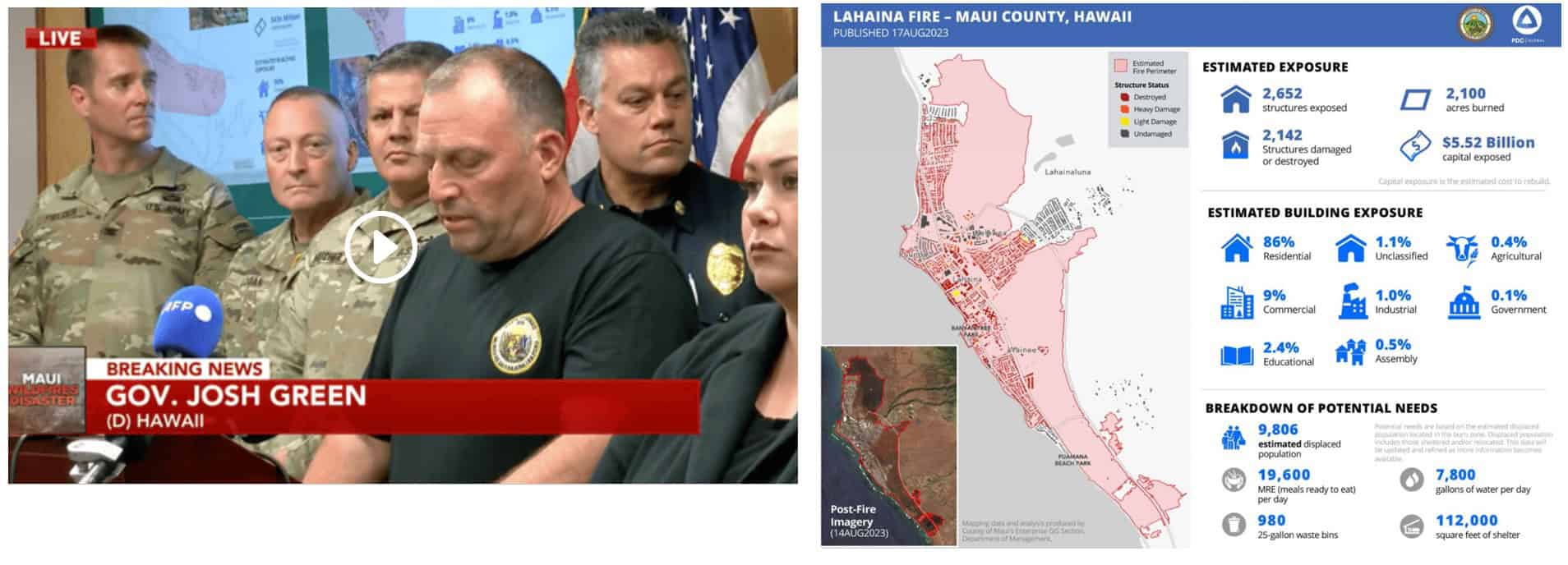
While large-scale logistics and relief efforts were ramping up, local grassroots initiatives and surrounding islands began sending essential supplies to those cut off from communication, food, water, and medical care. This wave of support, known as “aloha resilience,” inspired organizations worldwide to join the effort, arriving in Maui by the thousands.
Ongoing Support and Coordination
The need for effective coordination and a shared understanding of the situation grew rapidly. PDC’s DisasterAWARE platform played a crucial role in aggregating, analyzing, and sharing daily updates at the emergency operations center. For the next six months, PDC’s geospatial experts continued to process and map new information, supporting field operations and public information campaigns. Through its partnership with Maui’s Volunteer Organizations Active in Disasters (Maui VOAD), PDC also helped map, analyze, and match incoming offers with requests for help.

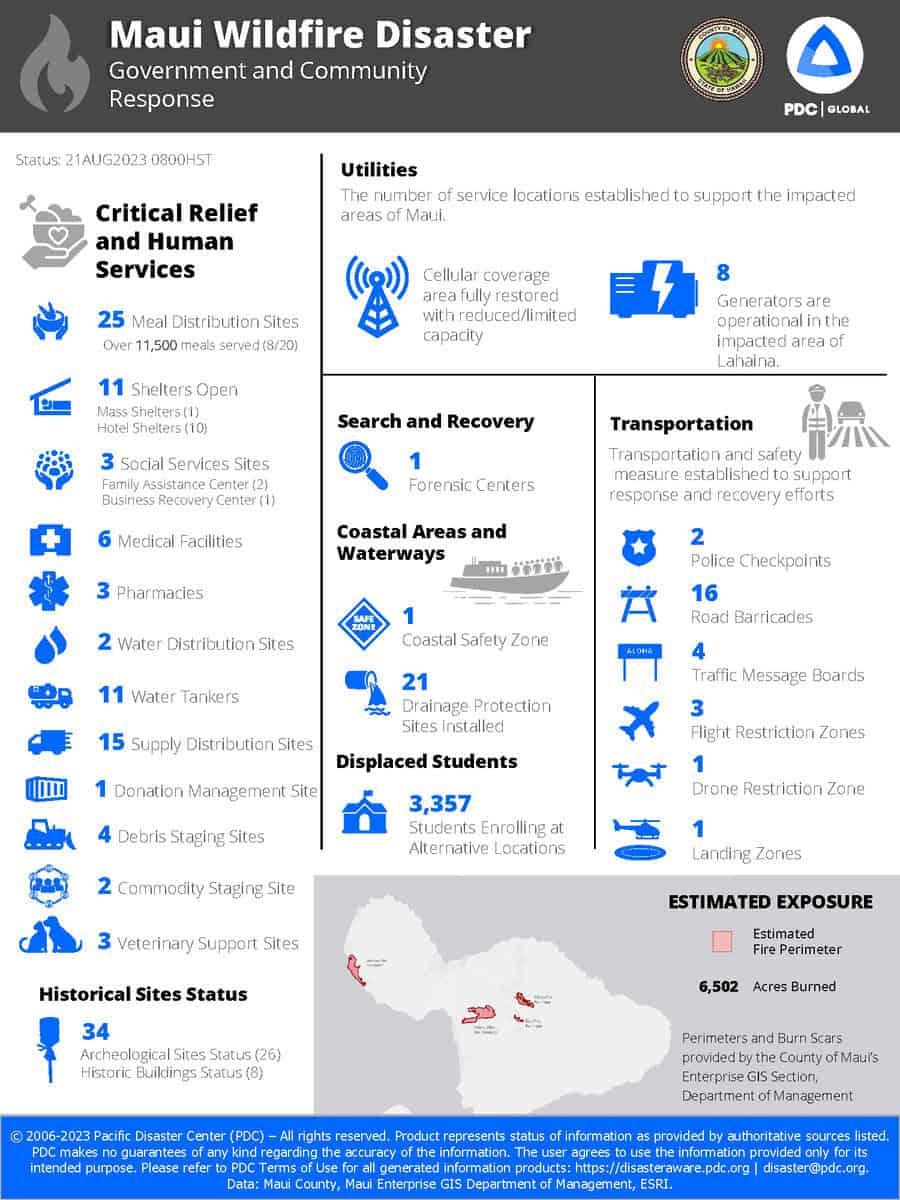
Championing Long-Term Recovery
PDC’s commitment to Maui’s recovery has remained steadfast since the morning after the tragedy took place. As a member of Hawaii State VOAD, PDC has hosted meetings with the County of Maui VOAD group, facilitating essential planning and support for recovery initiatives.
One such notable initiative is the formation of the Ho’ōla iā Mauiakama Disaster Long-Term Recovery Group, which provides critical services to those affected by the wildfire. PDC’s state liaison, Annie Collopy, has been elected Vice-Chair of the Maui County VOAD (2024-2025), a role that will enhance PDC’s involvement in Maui’s long-term recovery through various volunteer programs.
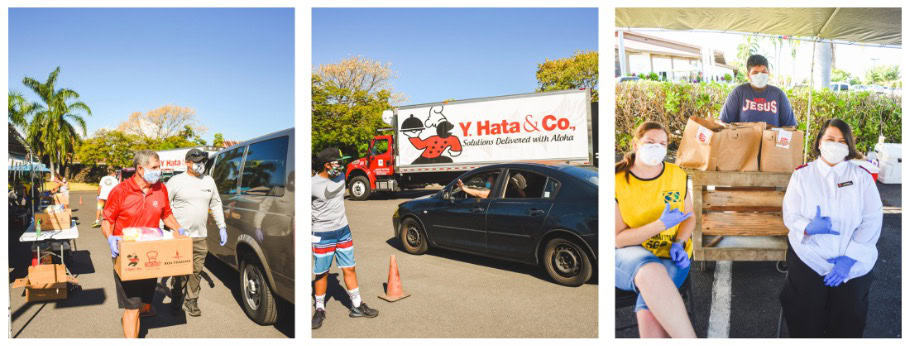
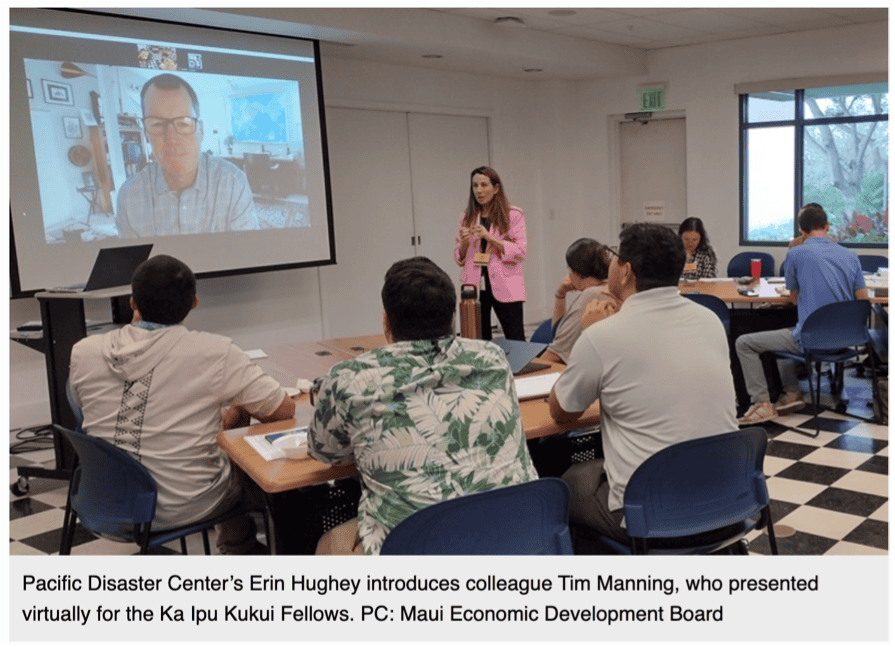
Empowering Future Leaders
In 2024, PDC participated in the Ka Ipu Kukui Fellows Program, sponsored by the Maui Economic Development Board (MEDB). This initiative aims to cultivate emerging leaders in Maui by highlighting the importance of disaster resilience. PDC’s executive team educated fellows on disaster management, and resilience measurement, and led a table-top exercise to simulate response complexities for future planning.
Community Outreach and Education
PDC remains dedicated to disaster preparedness education for all community members. In May 2024, Dr. Erin Hughey, PDC’s Deputy Executive Director, presented at Maui’s ProArts Playhouse, organized by the Kīhei Community Association. The presentation covered PDC’s scientific capabilities, including the Disaster Alert mobile app, and provided practical tips for disaster readiness.
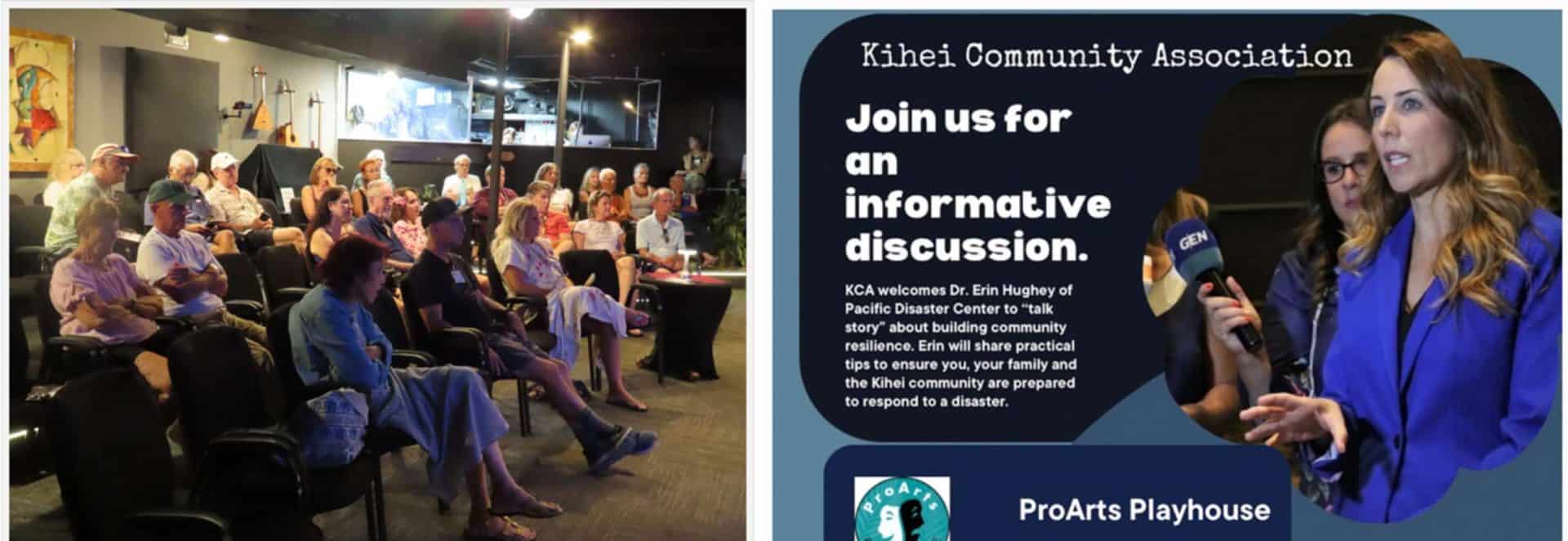
Advancements in Wildfire Monitoring and Early Warning
As part of the global initiative to enhance early warning systems, PDC has unveiled a suite of advanced global wildfire monitoring and early warning tools through its DisasterAWARE platform. This development is the result of PDC’s ongoing collaborations with scientific and academic partners and provides more precise modeling of wildfire impacts on populations and infrastructure to inform decision-makers with more timely and accurate information on wildfire severity.
One of the most notable innovations was a system first launched by PDC in 2019 and recently updated in June 2024. Through its partnership with NASA, PDC has been able to expand global wildfire detection and early warning coverage by 30 percent. This enhancement utilizes two satellites, MODIS and NOAA-21, as opposed to one, and provides continuous wildfire detection during both day and night at four-hour intervals, reducing the previous six-hour data lag.
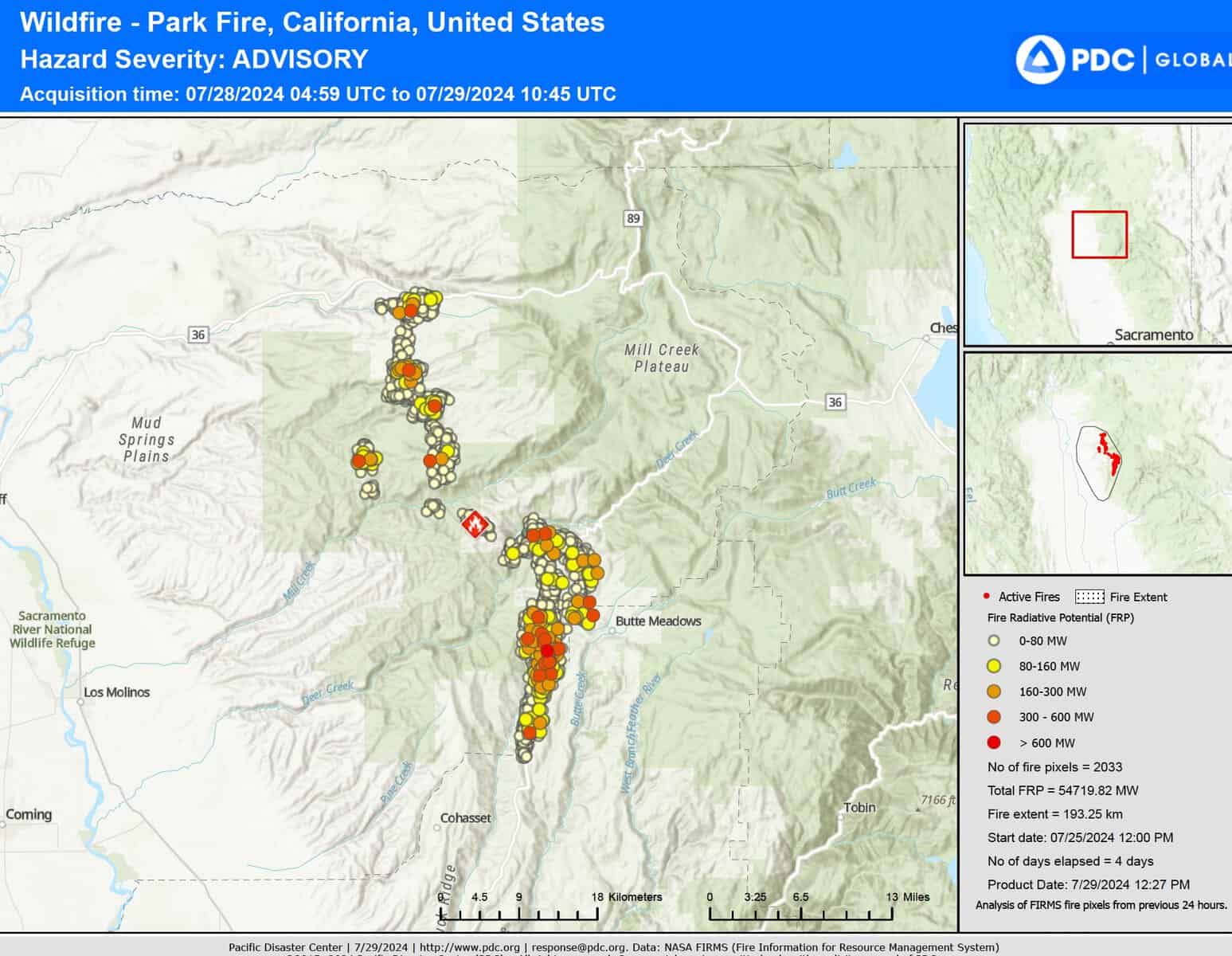
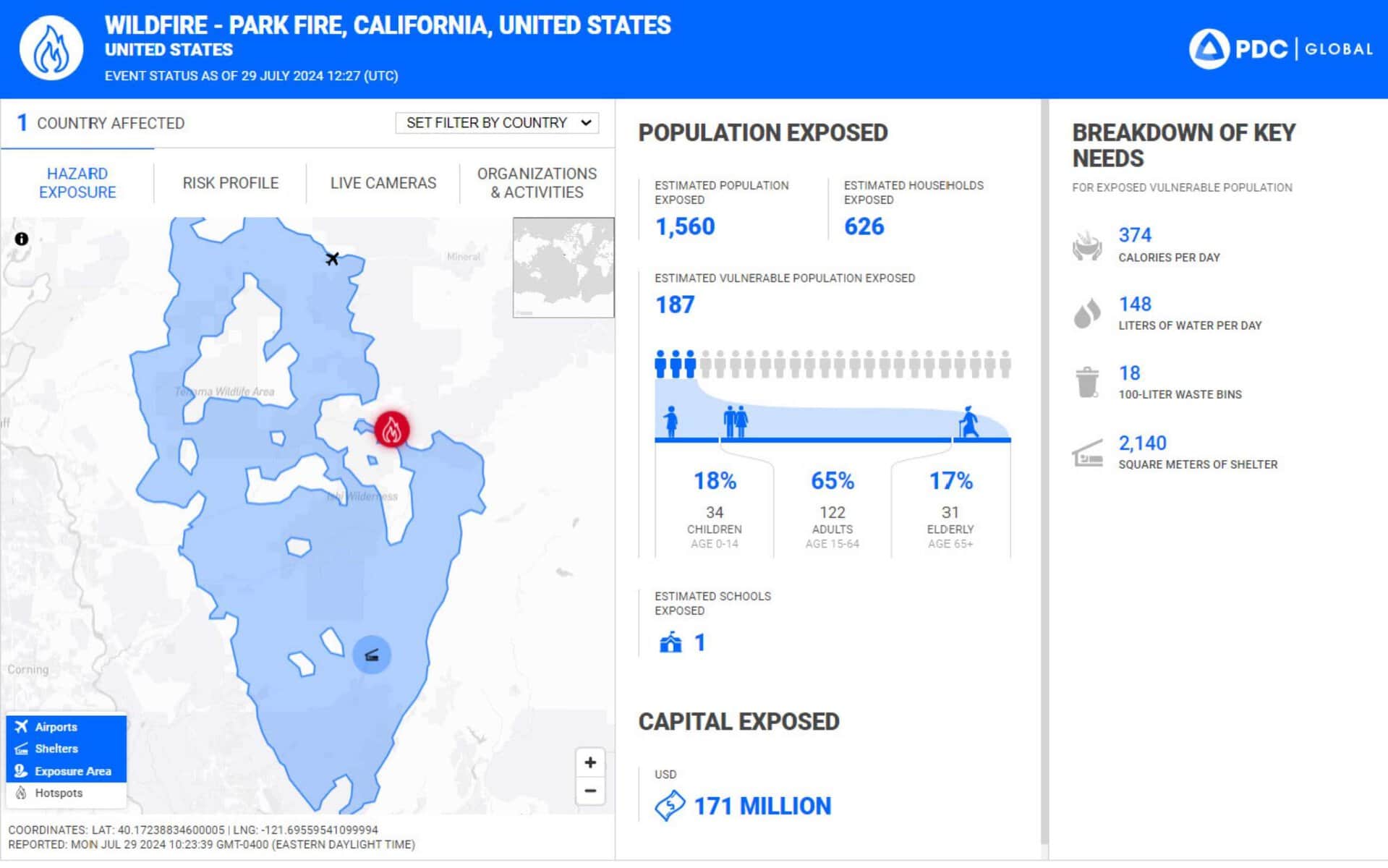
Algorithmic improvements have also been implemented to reduce data latency and enhance the accuracy and timeliness of wildfire perimeter mapping.
In addition to space-based monitoring, PDC has partnered with the University of Hawai’i to integrate enhanced U.S. wildfire data and fire weather information into DisasterAWARE. This dynamic data feed, which is updated regularly, supports fire control agencies across the U.S., including the Hawaiian Islands, in managing wildfires and protecting lives and property.
The new information derived from NOAA helps identify areas in the continental U.S. where existing fuel conditions, combined with forecasted weather, pose significant risks for wildfire ignition and spread.
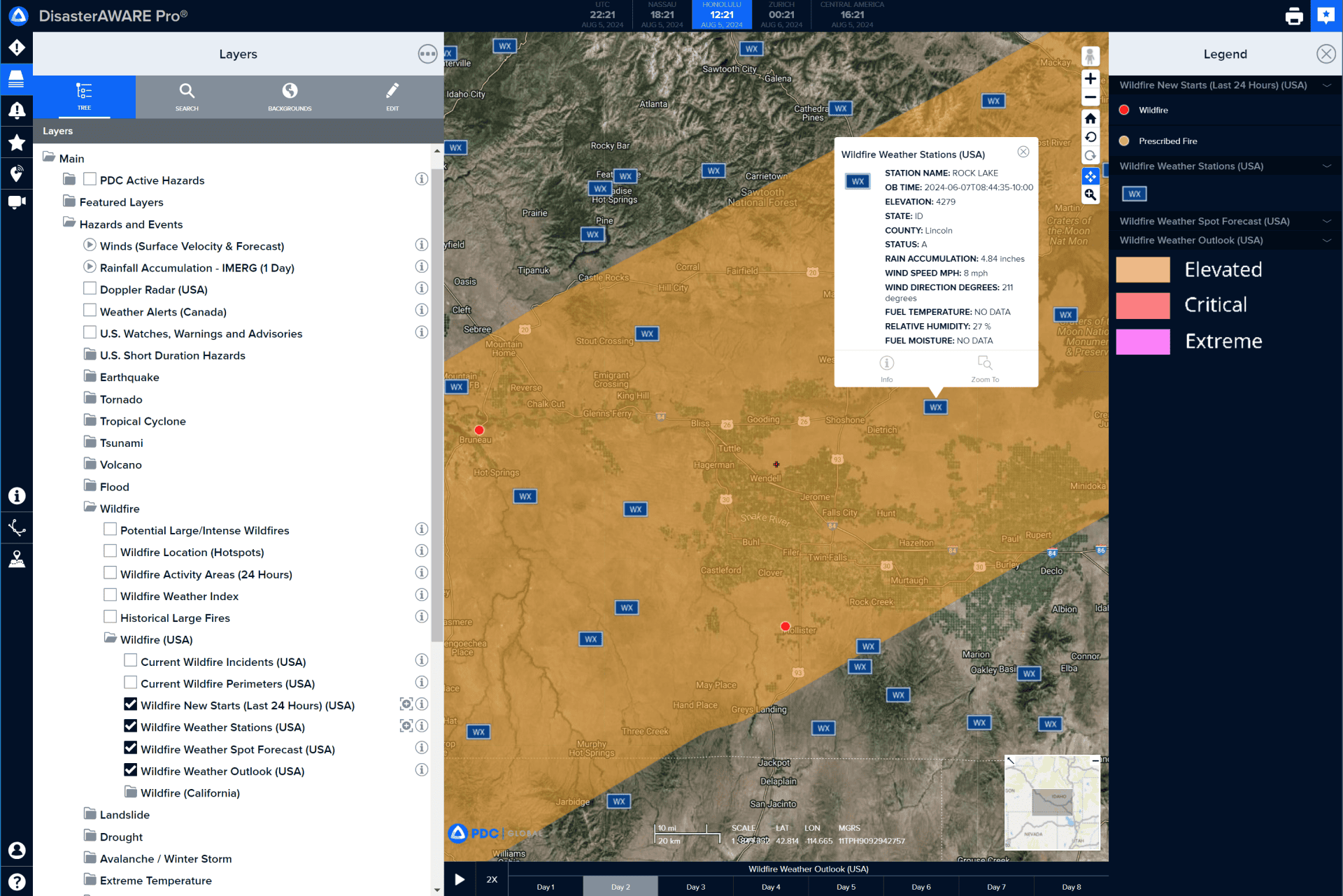
Future Training and Exercises
“The more resources that MFD has in its arsenal to detect and monitor wildfires, the quicker they can take action to mitigate impacts.”
Working with the Maui Fire Department (MFD), PDC is helping to conceptualize a 2024 fire preparedness training exercise by providing support for scenario development and data visualization. PDC is also working with MFD personnel to integrate fire sensor data into DisasterAWARE for enhanced early warning.
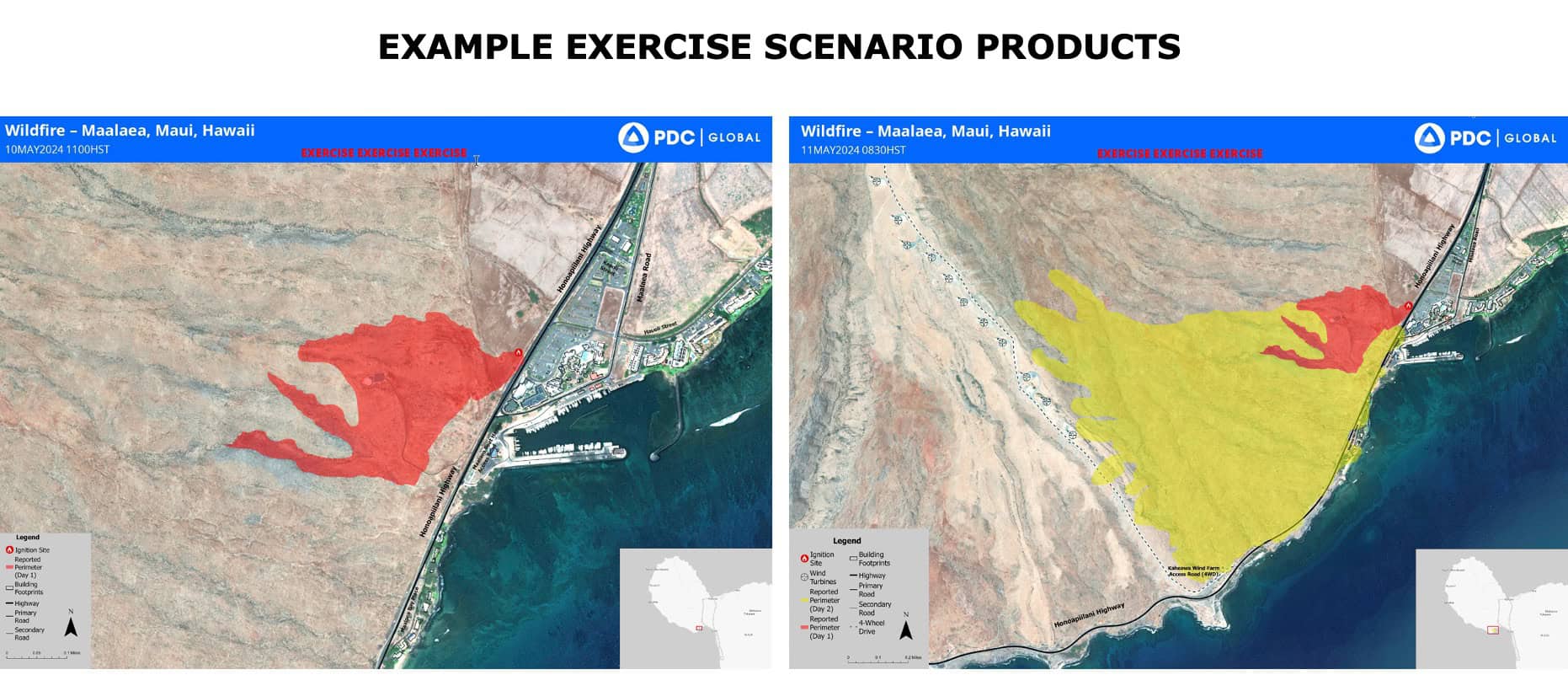
“The more resources that MFD has in its arsenal to detect and monitor wildfires, the quicker they can take action to mitigate impacts. As we enter the height of wildfire season across the Hawaiian islands, PDC is committed to supporting MFD and the Maui community with the best available data and technology for wildfire early warning and monitoring. Alongside our valuable first responders, it is also the mission of PDC to ensure the safety of our community,” said PDC’s interim Director of Global Operations Todd Bosse who has helped lead these important initiatives.
A Long Road to Recovery Ahead
“The severity of this wildfire event ranks among the worst in U.S. history, and we anticipate a prolonged and challenging recovery process. The complex issues our community leaders are confronting necessitate the most accurate data and scientific insights available. We are committed to supporting them every step of the way.”
—PDC’s Deputy Executive Director Dr. Erin Hughey.
“PDC’s core mission is to safeguard lives and property by providing decision-makers worldwide with cutting-edge early warning systems, analytics, and risk assessments. Our Center is constantly evolving, pushing the boundaries of what is possible through advanced data processing, sophisticated modeling, and innovative applications of artificial intelligence. Our goal extends beyond protecting our local Hawaiian communities and ʻohanas (families) as we strive to create a safer world for everyone.”
ABOUT PDC
Pacific Disaster Center (PDC) is a leading scientific innovator of global risk reduction science and technology. As a University of Hawai’i applied science and research center, our work intersects with a variety of government, community, academic, and scientific organizations at home and around the world to build resilience to natural and man-made hazards and enhance the capacity to quickly and accurately anticipate and prepare for new and emerging threats. Our innovations in multi-hazard early warning systems, predictive analytics, data science, and machine learning provide decision-makers with the powerful tools and insights they need to navigate today’s complex and interconnected risk landscape.

